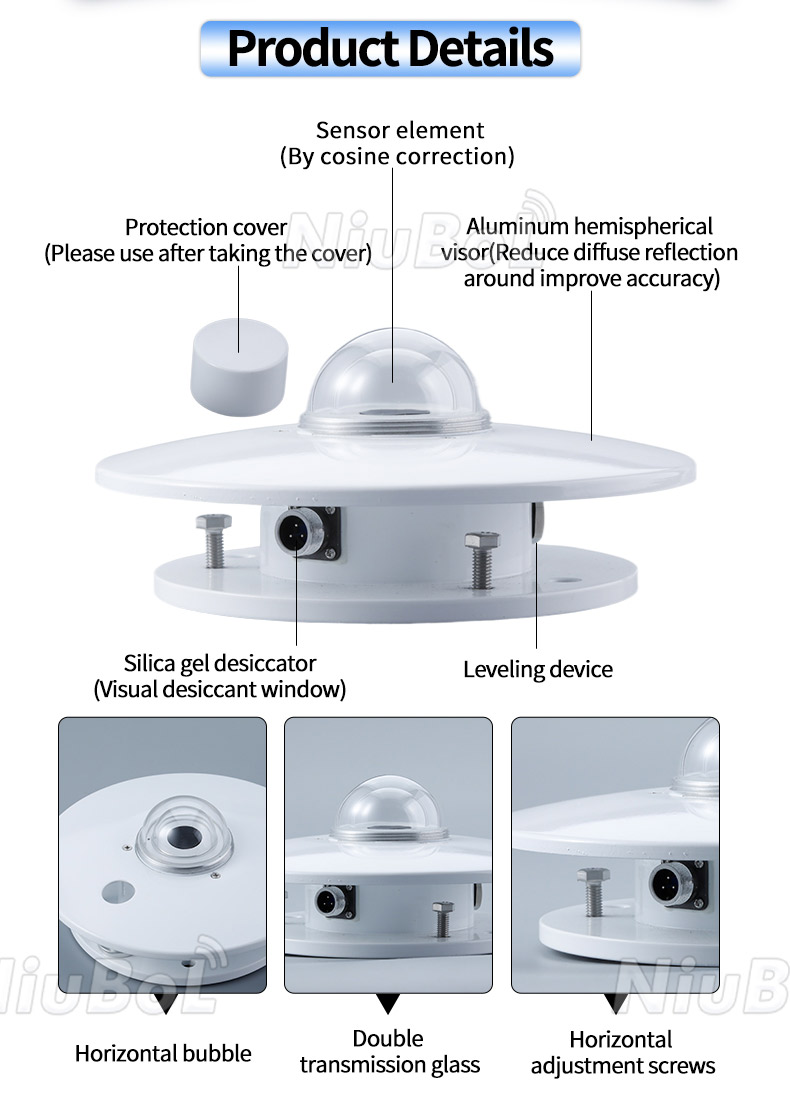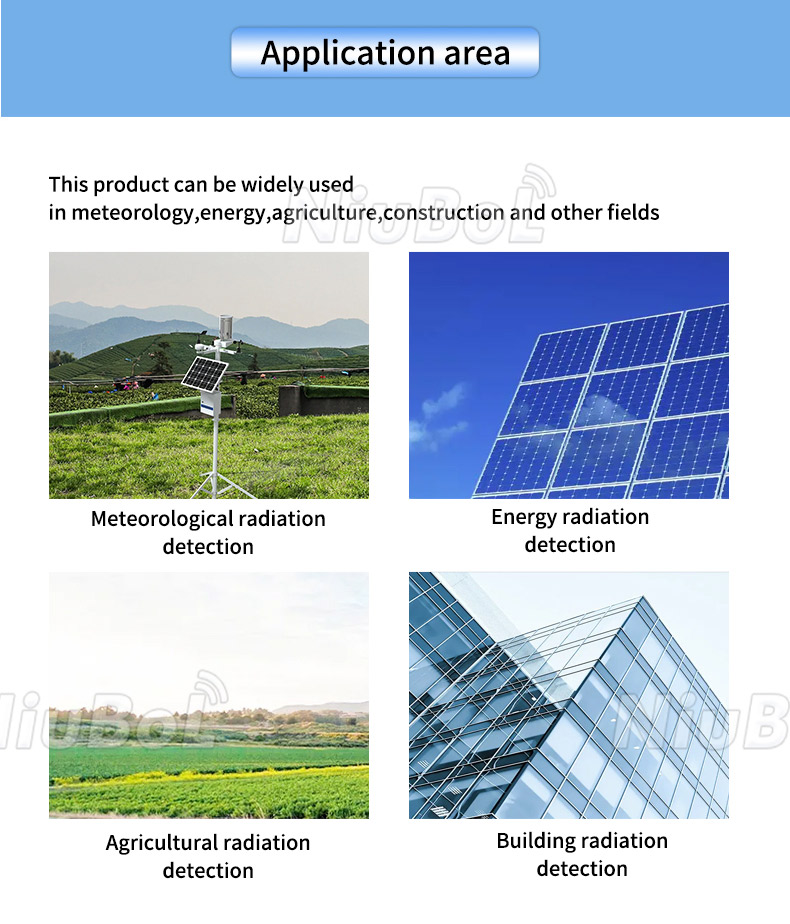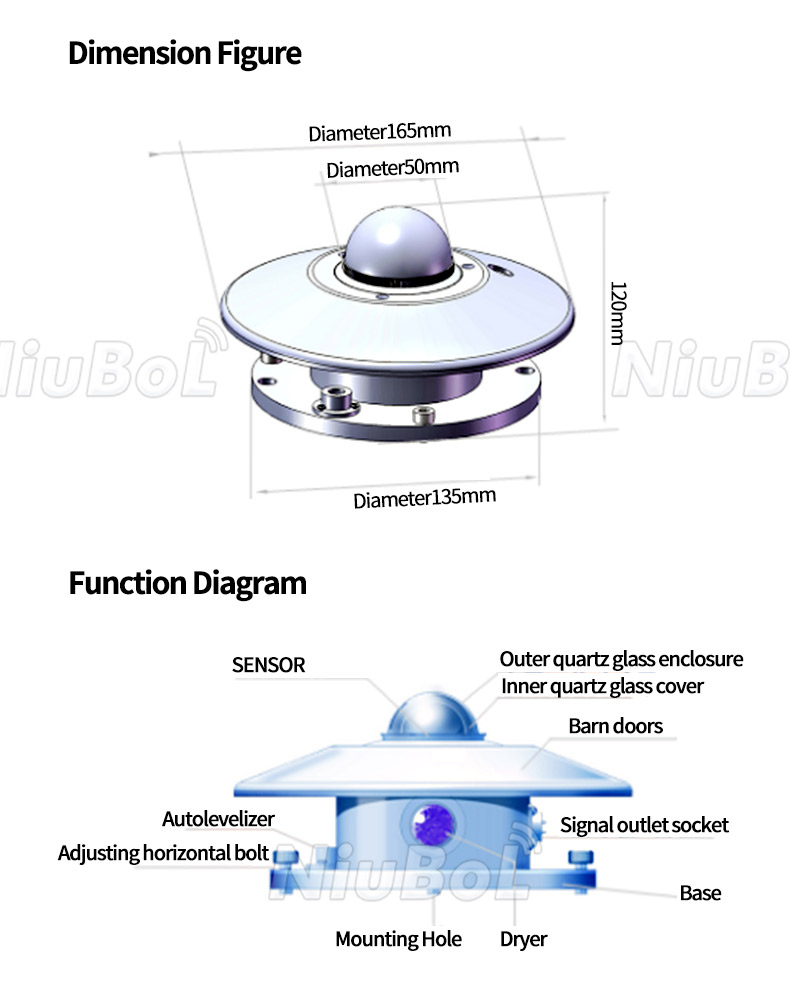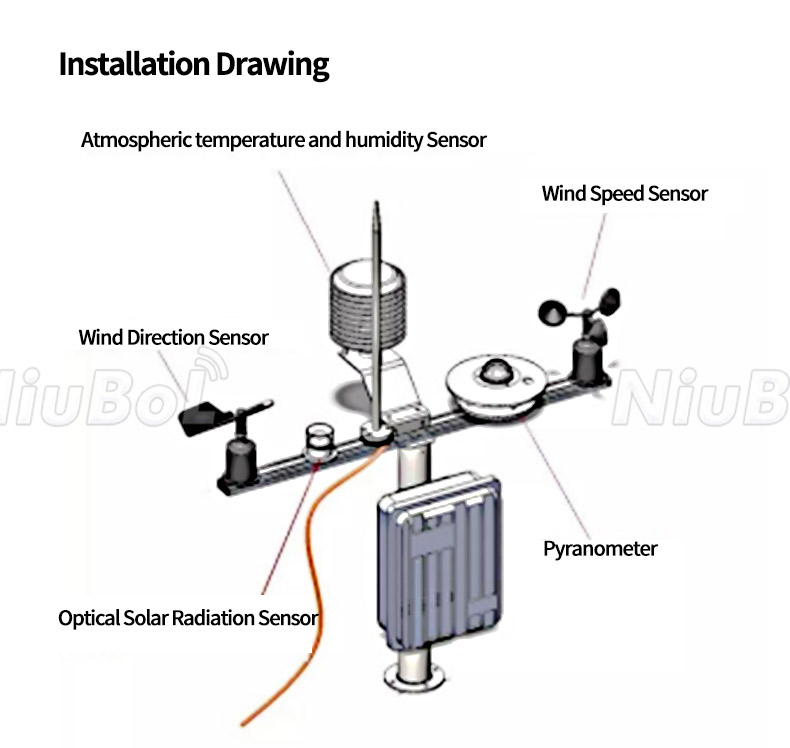

— Blogs —
—Products—
 Consumer hotline +8618073152920
Consumer hotline +8618073152920 WhatsApp:+8615367865107
Address:Room 102, District D, Houhu Industrial Park, Yuelu District, Changsha City, Hunan Province, China
Product knowledge
Time:2024-08-31 17:02:25 Popularity:270
A pyranometer, or solar intensity meter, is an instrument used to measure the intensity of solar radiation. It is designed to measure the solar irradiance of the entire hemisphere above the sensor, including direct solar radiation, diffuse radiation, and reflected radiation from the ground and surrounding surfaces. The pyranometer plays a vital role in solar energy applications and meteorological monitoring. It provides accurate data on the amount of solar radiation, which helps to assess the potential of solar energy resources and to optimise the performance of solar energy systems.
Pyranometers (solar radiometers) play an important role in a variety of fields such as meteorology, solar energy research, agricultural science, and building energy efficiency assessment. A Pyranometer works by detecting the intensity of radiation by means of a sensing element, such as a thermopile or photodiode, and converting it into measurable electrical signals. These signals can be further processed to provide a radiant flux density, usually in watts per square metre (W/m²).

When choosing a pyranometer, the following key factors need to be considered to ensure that it meets the needs of your particular application:
1. pyranometer measurement range:
- Determine the range: The measurement range of the pyranometer should cover the maximum and minimum intensity of radiation you expect. Ensure that the chosen instrument can adapt to environments ranging from low to zero to high radiation intensity ( range of 300nm to 3000nm ).
2. Accuracy and stability:
- High accuracy: Choose a solar radiometer with high accuracy and low uncertainty, traceable to international standards such as ISO 9060, and classified as ‘Class II’, ‘Class I’, or ‘Advanced’. Classifications such as ‘Class II’, ‘Class I’, or ‘Advanced’.
- Long-term stability: Instruments with good long-term stability reduce the need for frequent recalibration. 3.
3. Response time:
- Fast Response: Solar radiation changes rapidly, so the response time of a solar radiometer is also an important consideration. Shorter response time can more accurately capture the rapid changes in radiation intensity, improve the measurement of real-time and accuracy.
4. Environmental adaptability:
- Environmental conditions: consider the environmental conditions under which the instrument will be deployed, including temperature, humidity, wind speed, etc. Select a solar radiometer that can withstand these conditions to ensure long-term stability and accuracy.
5. Spectral Response:
- Spectral Matching: The spectral response of the solar radiometer should match the solar spectrum. Generally, an ideal solar radiometer should have good response in the wavelength range of 300nm to 3000nm.

6. Maintenance and calibration:
- Maintenance requirements: Consider the maintenance requirements of the instrument and select a model that is easy to clean and calibrate.
- Calibration intervals: Understand calibration intervals and costs. Regular calibration is essential to maintain measurement accuracy.
7. Connectivity and data compatibility:
- Connectivity: Check connectivity options to ensure compatibility with your data logging system.
- Data compatibility: Ensure that data can be easily logged and exported.
8. Cost effectiveness:
- Total cost of ownership: Evaluate purchase price, calibration costs, maintenance costs and life expectancy to select a cost-effective product.

9. Technical support and warranty:
- Support services: Select a manufacturer that offers good technical support and a competitive warranty policy.
10. Application requirements:
- Specific needs: according to your specific application (e.g. specific band measurement), including expected radiation level, environmental conditions, measurement accuracy requirements, etc.. Select a solar radiometer with the appropriate characteristics.
When selecting a solar radiometer, you may also want to consider the following factors:
- Operator interface: Choose an instrument that is easy to operate and understand, especially for non-expert users.
- Protection: Ensure that the instrument has appropriate protective measures, such as sun shields, dust covers, etc., to protect the instrument from environmental factors.
- Ease of use: Select instruments that are easy to use, including data logging and export capabilities.
11. Consider the measurement principle:
- If high sensitivity and good long-term stability are required, a thermopile solar radiometer may be a better choice.
- If fast response and simple maintenance are key considerations, a photovoltaic solar radiometer may be more appropriate.

Pyranometers can be categorised according to their principle of operation. The following are two common classifications that include pyranometers based on different principles:
- Thermopile Pyranometers: These solar radiometers use a thermopile as the sensing element. The thermopile consists of a number of thermocouples connected in series. When solar radiation hits the absorber plate, the plate heats up, creating a temperature difference with the other end of the thermopile, which generates an electric potential. This electromotive force is proportional to the amount of solar radiation hitting the absorber plate. Thermopile solar radiometers usually have the following characteristics:
- High sensitivity: able to detect small changes in radiation.
- Wide spectral response: designed to match the distribution of the solar spectrum as closely as possible.
- Good stability: small changes in performance over long periods of time.
- Regular calibration is required: In order to maintain measurement accuracy, regular calibration is required.
- Photovoltaic Pyranometers: This type of solar radiometer utilises the photovoltaic effect, whereby light energy is converted directly into electrical energy. Photovoltaic Pyranometers usually contain one or more photovoltaic cells, which generate an electric current when solar radiation hits them, the magnitude of which is proportional to the intensity of the solar radiation. Characteristics of photovoltaic solar radiometers include:
- Simple construction: usually has no moving parts and is therefore more durable.
- Fast response: able to respond quickly to changes in radiation.
- Possible spectral dependence: the response of the PV cell may not exactly match the solar spectrum, which may affect the accuracy of the measurement.
- Temperature effects: the output of the PV cell may be affected by changes in temperature.

In summary, there are a number of factors to consider when choosing a pyranometer, including measurement range, accuracy, response time, stability and durability, ease of use, application requirements, measurement needs, environmental conditions, cost-effectiveness, and manufacturer support, as well as price. By carefully evaluating these factors, you can select the pyranomete that is best suited to your application, resulting in accurate and reliable solar radiation data.
NBL-W-HPRS-Solar-Radiation-Sensor-Instruction-Manual-V3.0.pdf
Related recommendations
Sensors & Weather Stations Catalog
Agriculture Sensors and Weather Stations Catalog-NiuBoL.pdf
Weather Stations Catalog-NiuBoL.pdf
Related products
 Combined air temperature and relative humidity sensor
Combined air temperature and relative humidity sensor Soil Moisture Temperature sensor for irrigation
Soil Moisture Temperature sensor for irrigation Soil pH sensor RS485 soil Testing instrument soil ph meter for agriculture
Soil pH sensor RS485 soil Testing instrument soil ph meter for agriculture Wind Speed sensor Output Modbus/RS485/Analog/0-5V/4-20mA
Wind Speed sensor Output Modbus/RS485/Analog/0-5V/4-20mA Tipping bucket rain gauge for weather monitoring auto rainfall sensor RS485/Outdoor/stainless steel
Tipping bucket rain gauge for weather monitoring auto rainfall sensor RS485/Outdoor/stainless steel Pyranometer Solar Radiation Sensor 4-20mA/RS485
Pyranometer Solar Radiation Sensor 4-20mA/RS485
Screenshot, WhatsApp to identify the QR code
WhatsApp number:+8615367865107
(Click on WhatsApp to copy and add friends)